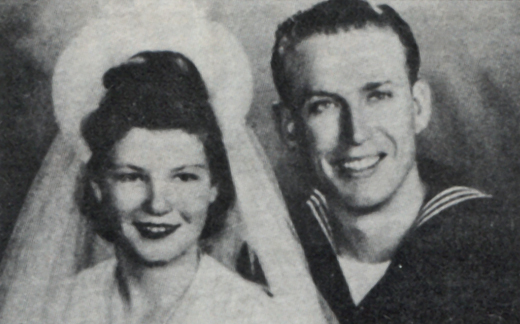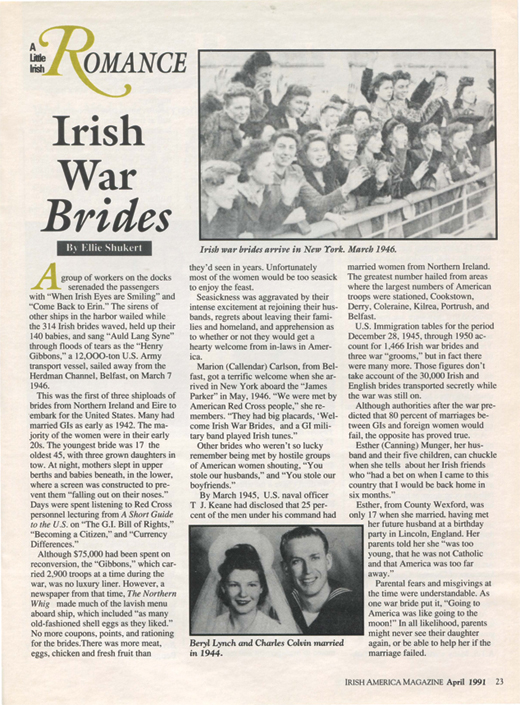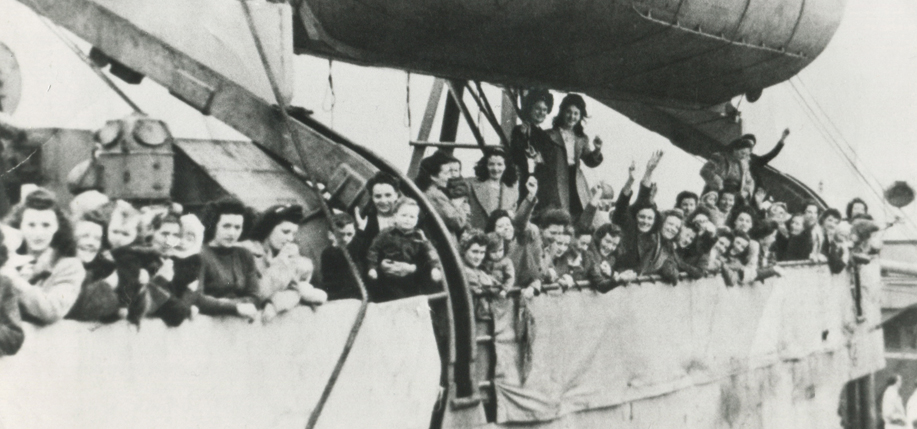A group of workers on the docks serenaded the passengers with “When Irish Eyes are Smiling” and “Come Back to Erin.” The sirens of other ships in the harbor wailed while the 314 Irish brides waved, held up their 140 babies, and sang “Auld Lang Syne” through floods of tears as the Henry Gibbins, a 12,000-ton U.S. Army transport vessel, sailed away from the Herdman Channel, Belfast, on March 7, 1946.
This was the first of three shiploads of brides from Northern Ireland and Éire to embark for the United States. Many had married GIs as early as 1942. The majority of the women were in their early 20s. The youngest bride was 17, the oldest 45, with three grown daughters in tow. At night, mothers slept in upper berths and babies beneath in the lower, where a screen was constructed to prevent them “falling out on their noses.” Days were spent listening to Red Cross personnel lecturing from A Short Guide to the U.S. on “The GI Bill of Rights,” “Becoming a Citizen,” and “Currency Differences.”
Although $75,000 had been spent on reconversion, the Gibbins, which carried 2,900 troops at a time during the war, was no luxury liner. However, The Northern Whig, a newspaper from that time, made much of the lavish menu aboard ship, which included “as many old-fashioned shell eggs as they liked.” No more coupons, points, and rationing for the brides. There was more meat, eggs, chicken, and fresh fruit than they’d seen in years. Unfortunately most of the women would be too seasick to enjoy the feast.
Seasickness was aggravated by their intense excitement at rejoining their husbands, regrets about leaving their families and homeland, and apprehension as to whether or not they would get a hearty welcome from in-laws in America.
Marion (Callendar) Carlson, from Belfast, got a terrific welcome when she arrived in New York aboard the James Parker in May 1946. “We were met by American Red Cross people,” she remembers. “They had big placards, ‘Welcome Irish War Brides,’ and a GI military band played Irish tunes.”
Other brides who weren’t so lucky remember being met by hostile groups of American women shouting, “You stole our husbands,” and “You stole our boyfriends.” By March 1945, U.S. naval officer T.J. Keane had disclosed that 25 percent of the men under his command had married women from Northern Ireland. The greatest number hailed from areas where the largest numbers of American troops were stationed, Cookstown, Derry, Coleraine, Kilrea, Portrush, and Belfast.
U.S. Immigration tables for the period from December 28, 1945 through 1950 account for 1,466 Irish war brides and three war “grooms,” but in fact there were many more. Those figures don’t take account of the 30,000 Irish and English brides transported secretly while the war was still on.
Although authorities after the war predicted that 80 percent of marriages between GIs and foreign women would fail, the opposite has proved true.

Esther (Canning) Munger, her husband, and their five children can chuckle when she tells about her Irish friends who “had a bet on when I came to this country that I would be back home in six months.”
Esther, from County Wexford, was only 17 when she married, having met her future husband at a birthday party in Lincoln, England. Her parents told her she “was too young, that he was not Catholic, and that America was too far away.”
Parental fears and misgivings at the time were understandable. As one war bride put it, “Going to America was like going to the moon!” In all likelihood, parents might never see their daughter again, or be able to help her if the marriage failed.
One woman from Coalisland, County Tyrone, who had met her GI while working as a waitress in a hotel in England, sailed secretly aboard the Mauritania in February 1945 during wartime, along with 500 other brides, 200 babies, and 1,500 wounded soldiers. She remembers how they “took a zigzag course on account of U-boats.”
“Because of the U-boat threat,” another war bride aboard recalled, “I wasn’t allowed to notify anyone that I was on my way. All our written material had been censored – even my Bible – and was put into sealed packages which we weren’t allowed to open until we got to the U.S. There were no pressmen on the dock; it was all hush-hush because the war was still on.”
Another bride who came over secretly with 13 other women during the war remembers that puzzled soldiers aboard who saw these unaccounted-for women in the officers’ dining room and lounge started rumors that “the girls onboard were there for the entertainment of the officers.” The next day, it was announced that they were war brides.
Most war brides still marvel at how easily attracted they were to those Yanks in their smart uniforms, smelling of Old Spice, generous to a fault.
Marion Carlson, who met her Yank at an American Red Cross event, feels that basically there wasn’t really all that much difference between Irish and American men, “except Americans seem[ed] to treat women nicer, sending flowers, candy, and the like.”
According to Lillian “Betty” (Kearney) Frantz of Belfast, who met her husband on a blind date while working in England during the war, American men were “better dressed,” but “failed to use a knife and fork properly when eating, failed to open doors or light a cigarette, but treated women like queens.”
Some Irish women served in the British A.T.S. (Auxiliary Territorial Service) during the war and met their American husbands on the job. “Both of us worked in the Headquarters Allied Armies, Italy,” says Phyllis (Boyack) Lancaster of Clonmel, County Tipperary. Although she often found GIs to be “loud and brassy,” she also thought them “more outgoing” than British men.
At her wedding in October 1945, Phyllis wore an often-borrowed wedding gown, on loan from a Canadian women’s group to members of the A.T.S. Many wartime gowns were fashioned out of parachute silk. Gauze bandages were transformed into wedding veils.
Jean (Campbell) Corda, of Lisburn, County Antrim, who met Pvt. Elmer Corda at the movies in her hometown, remembers “three of us girls married Americans in the same church by the same minister on March 27, 1943.” Not long after they settled in Oregon, rising waters from the Columbia River broke a railroad dike and flooded their town. For a while, their only shelter was a tent. Elmer told Jean he wouldn’t blame her if she packed up and went back to Ireland. Jean told him that World War II brought them together and she wasn’t about to let hell or high water chase her away.
“We had our struggles,” Jean admits. “We didn’t have a lot when we first came, but we managed. You go up the hill and get kicked back down, then you go back up again. My mother used to tell me that when one door closes, another always opens up.”
“I wouldn’t do it again!” says Sally Kastl of Belfast in her clearly Irish brogue. She hasn’t forgotten that she “cried for five years” from homesickness. However, her mother-in-law, an English war bride from World War I, provided some understanding.
Getting a job with Michigan Bell Telephone Company as an operator helped Lillian Frantz get through her homesickness. In 1953 she was promoted to management and retired after 28 years of service.

“The terrible heat in Oklahoma,” was the worst thing at first for Marion Carlson to get used to. She, too, found satisfaction in a career and a happy marriage.
Sally, now a proud grandmother, is still as fiery as ever. She lives with her husband Frank in San Francisco, where neighbors have dubbed her “the mayor of San Bruno Avenue,” because of all the letters she writes to the city council and her involvement in political affairs affecting her neighborhood.
As much as Sally misses her homeland and Irish family, leaving was a liberating experience for her. “I had red hair down to my hips; Mother didn’t believe in cutting hair. First thing I did was get it cut!”
A friend who traveled recently in Ireland told me he stayed at a bed-and-breakfast, where he asked the proprietor about the photo of a Yank he spied on the parlor wall. “It’s me,” he answered. He turned out to be one of an unknown number of GIs who chose to stay in Ireland with his Irish bride.
On December 28, 1945, Public Law 271, known as the War Brides Act, was passed by Congress. The act facilitated the entry of alien spouses of U.S. servicemen by granting them nonquota status. This act remained in effect for three years, until December 28, 1948. ♦
_______________
Ellie Shukert is the author of War Brides of World War II, published by Penguin Books. This article was published in Irish America in April 1991. War bride Sally Kastl passed away in 2004.


My mother, Doris Gordon and my sister Rosemary traveled in a war brides ship headed for Newton,Iowa. I know the newspaper photographers were there for the end of their journey. They were published in a newspaper which I think was in Newton. I’m wondering if she featured in any of your exhibits. I understand it may not have been part of your information. I would so like to have some knowledge about their trip. Thank you, Sharon Gaston. nee Gordon
My Grandmother was Esther (Canning) Munger!!! She was so proud to be in a book although this is the only article I could find. Thank you!!
My mother-in-law was only 15 when she married an American soldier. Her husband sent her to his family in America. She came with 4 other war brides on a war ship convoy. She learned English by going to movies and reading comic books. She has so many amazing stories. She is 93 and is truly a beautiful woman. I wish someone would write her life story.
Dolores, please consider sharing your mother-in-law’s story with Irish America. Please see the story of Bridget Murray, https://www.irishamerica.com/2021/02/an-ordinary-woman-who-lived-an-extraordinary-life/. This was written by her daughter Eileen Murray with assistance from her siblings. You may send the story to submit@irishamerica.com.
My mother was a war bride and I’ve enjoyed your article very much! I just ordered your book. Thank you for writing such a wonderful article.
I am also a World War II war bride. I left Paris, France on March 7, 1946 to go to LeHarve, France to board the Vulcania, a luxury ship requisitioned from the Italians. We stopped in South Hampton to pick up several hundred British, Scottish, etc. war brides. We arrived at Ellis Island in New York City and the American military greeted us and took us on a tour or NYC. They put us on trains to various parts of the United States.
Hello, I’m the daughter of am irish war brides naturalized in LA in 1948. Is there a contact for decendents of other irish war brides.
Visit us at WWII War Brides and family on Facebook. Please stop by and learn more about our war brides. We also have a National Origination if you are interested to join. For more information email me at uswarbrides@yahoo.com